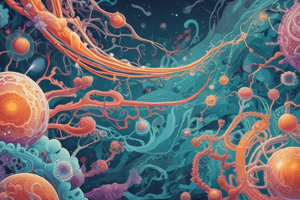Podcast
Questions and Answers
Which of the following are types of culture media based on their consistency?
Which of the following are types of culture media based on their consistency?
- Semi solid medium (correct)
- Liquid medium (correct)
- Solid medium (correct)
- Complex medium
What is the earliest liquid medium used by Louis Pasteur?
What is the earliest liquid medium used by Louis Pasteur?
Urine or meat broth
What is agar derived from?
What is agar derived from?
Seaweed
Complex media consists of a mixture of many chemical species in unknown proportions.
Complex media consists of a mixture of many chemical species in unknown proportions.
The percentage of agar commonly used in solid medium is ___%.
The percentage of agar commonly used in solid medium is ___%.
What type of media is blood agar classified as?
What type of media is blood agar classified as?
What is a common example of a simple medium?
What is a common example of a simple medium?
Which of the following are types of special media?
Which of the following are types of special media?
Match the following media with their primary usage:
Match the following media with their primary usage:
Selective media contains an indicator that changes color when bacteria grow.
Selective media contains an indicator that changes color when bacteria grow.
What is the purpose of differential media?
What is the purpose of differential media?
Flashcards
Culture Medium
Culture Medium
A substance used to grow microorganisms in a laboratory setting.
Solid Culture Medium
Solid Culture Medium
Culture medium that provides a solid surface for bacteria to grow into distinct colonies.
Agar
Agar
A solidifying agent derived from seaweed, used in culture media.
Colony
Colony
Signup and view all the flashcards
Liquid Culture Medium
Liquid Culture Medium
Signup and view all the flashcards
Simple Medium
Simple Medium
Signup and view all the flashcards
Selective Medium
Selective Medium
Signup and view all the flashcards
Differential Medium
Differential Medium
Signup and view all the flashcards
Enriched Medium
Enriched Medium
Signup and view all the flashcards
Nutrient Agar
Nutrient Agar
Signup and view all the flashcards
Study Notes
Culture Media
- Culture medium types:
- Liquid: Diffused growth, no distinct characteristics for identification, difficult to isolate. Earliest liquid media included urine or meat broth used by Louis Pasteur.
- Solid: Distinct colony morphology, characteristics are easily identified.
Solid Media
- Colony: Macroscopically visible collection of bacteria originating from a single cell.
- Earliest solid medium: Cooked potato (Robert Koch), but not satisfactory. Liquefied at 24°C.
- Gelatin: Not satisfactory, liquefied at 24°C.
- Agar: Universally used for solid media, derived from seaweed (Gelidium). Offers no nutritive value, unaffected by bacterial growth, melts at 98°C and solidifies at 42°C. 2% agar is commonly used.
Types of Culture Media
-
Based on consistency:
- Solid
- Liquid
- Semi-solid
-
Based on constituents/ingredients:
- Simple
- Complex
- Synthetic/defined
- Special
Special Media
- Enriched media: Supports growth of a wide variety of organisms, including fastidious ones (difficult to grow). Often used for pathogen isolation. Include blood agar (whole blood is added) and chocolate agar (heat-treated blood is added).
- Selective media: Contains inhibitory substances that prevent the growth of certain microorganisms, while allowing others to grow. Increase the number of desired bacterial colonies. Examples include desoxycholate citrate, Mac Conkey's medium, TCBS (Thiosulfate Citrate Bile Salt Sucrose), and LJ medium.
- Indicator media: Contain an indicator that changes color when a microorganism grows in it. Examples include Wilson-Blair agar (S. typhi black colonies) and urease medium (yellow oranged) where urease-producing bacteria turn the medium pink.
- Differential media: Incorporate substances that enable differentiation between bacteria. MacConkey's agar, for example, differentiates based on lactose fermentation (pink colonies for lactose fermenters and colourless for non-lactose fermenters).
Transport Media
- Used for transporting samples, preserving delicate organisms during transport. Stuart's medium is one example.
Anaerobic Media
- Used to cultivate anaerobic organisms, such as those in Robertson's cooked meat medium or Thioglycolate medium.
Culture Methods
- Methods depend on the purpose—isolating pure cultures, demonstrating properties, testing antigens, susceptibility to antibiotics, and viable count estimates. Includes streak culture, lawn culture, stroke culture, and stab culture.
Studying That Suits You
Use AI to generate personalized quizzes and flashcards to suit your learning preferences.




